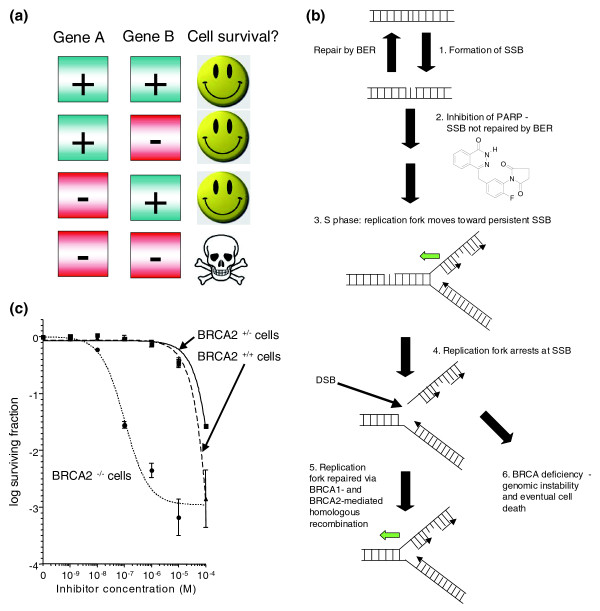Figure 5.
A synthetic lethal network exploited in cancer treatment. (a) Two genes or proteins are synthetically lethal when inactivation of either gene/protein is still compatible with cellular viability but inactivation of both leads to cell death [55]. Often synthetic lethal relationships represent networks of proteins that show a form of functional buffering. (b) A model for synthetic lethality using PARP inhibitors [54]. DNA is constantly damaged, both by environmental and by normal physiological processes. One of the more common forms of DNA damage is the formation of DNA single strand breaks (SSBs; step 1). SSBs are normally rapidly repaired by a process known as base excision repair (BER). BER is instigated by the activity of the poly(ADP ribose) polymerase, PARP1, and when PARP1 is inhibited (an example PARP inhibitor is shown), SSBs persist (step 2). As cells enter S phase, and DNA is replicated; replication forks are eventually stalled by persistent SSBs (step 3; the direction of a replication fork is shown by the green arrow). If not rapidly repaired, stalled replication forks can often degenerate and form DNA double strand breaks (DSBs), which are highly likely to be lethal (step 4). In normal cells, an additional DNA repair process, homologous recombination (HR), can repair stalled replication forks and DSBs (step 5). HR is mediated by BRCA1 and BRCA2 and acts as a functional buffer to enable normal cells to survive the effects of PARP and BER inhibition. Conversely, in patients with germ-line BRCA gene mutations, tumor cells show a severe HR defect (step 6). PARP inhibition combined with HR deficiency leads to tumor cell death either driven by the formation of lethal DSBs or because mutagenic forms of repair predominate in the absence of HR. The genomic instability that follows the use of these non-HR forms of DSB repair eventually limits the fitness and viability of tumor cells. (c) Synthetic lethality in in vitro cell culture. Clonogenic assays, which estimate tumor cell survival, demonstrate that tumor cells with either BRCA1 or BRCA2 deficiency are profoundly sensitive to potent PARP inhibitors such as KU0058948 (Kudos/AstraZeneca). Reproduced, with permission, from [54]. In vitro synthetic lethality translates into clinical synthetic lethality [56]. Computed tomographic (CT) scans of the abdomen in a patient with advanced ovarian cancer and BRCA mutation family history showed a reduction in the size of a peritoneal tumor nodule by 66% over a 4-month treatment period during which she received a potent PARP1 inhibitor, olaparib, at a dose of 100 mg, twice daily, for 2 of every 3 weeks. CT scans of the abdomen in another patient with advanced ovarian cancer, who had a BRCA1 mutation (4693delAA), showed complete regression of a peritoneal tumor nodule over a 4-month treatment period with olaparib (200 mg, twice daily) for a year.

